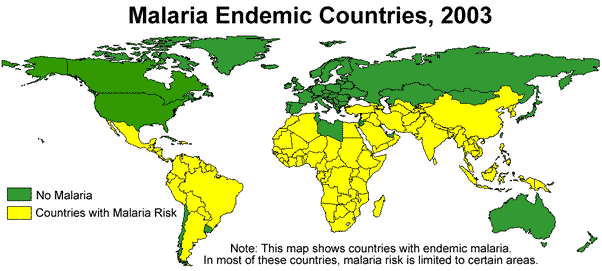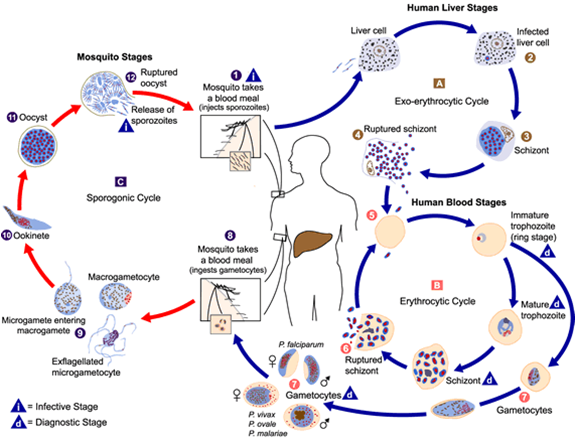


| Plasmodium type | Incubation period | Duration of infection if untreated |
|---|---|---|
| P. Falciparum | 12 days (9-60) | 1.5 years |
| P. Vivax and P. Ovale | 14 days (8-27, some temperate strains 8mths) | 5 years |
| P. Malariae | 30 days(16-60) | 50 years |
| Plasmodium Type | Pattern of symptoms |
|---|---|
| P. Falciparum | May be daily, continuous, or tertian |
| P. Vivax, P. Ovale | Tertian |
| P. Malariae | Quartan |

| Drug Class | Examples | Target site |
|---|---|---|
| 4-Aminoquinoline | Chloroquine, Hydroxy-chloroquine Amodiaquine | Blood Schizonticide (suppressive agent) Gametocide (P. Vivax, P. Ovale) |
| 8-Aminoquinoline | Primaquine | Tissue Schizonticide Gametocide (P. Falciparum) |
| Diaminopyrimidines: | Trimethoprim, Pyrimethamine | Blood schizonticide Pyrimethamine also sporonticide |
| Biguanides: | Proguanil, Chlorguanide, Chlorproguanil | Blood schizonticide Proguanil also sporonticide |
| Sulfonamides | Sulfadoxine, Sulfadiazine, Sulfamethoxazole | Blood schizonticide |
| Sulfones | Dapsone | Blood schizonticide |
| Cinchona Alkaloids | Quinine, Quinidine | Blood schizonticide |
| 4-quinoline-carbinolamines | Mefloquine | Blood schizonticide |
| Antibiotics | Tetracycline Vibramycine Clindamycin | Blood schizonticides |
| Others | Halofantrin Artemisinin (quinghaosu) Atovaquone | Blood schizonticides |
| Combination | Fansidar (Pyrimethamine + Sulfadoxine) Maloprim (Pyrimethamine + Dapsone) Malarone (Atovaquone + Proguanil) | Blood schizonticides and sporonticides Atovaquone (also tissue schizonticide for P. falcip) |